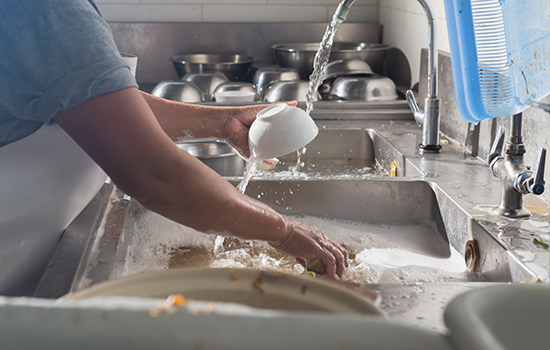Return to Service Flushing Guidelines
Protect the health and safety of your occupants
Aquarion Water Company reminds schools and business owners who have closed their buildings during the pandemic to flush building water systems prior to returning to normal use of their tap water. After an extended period of non-use, potable water can become stagnant. By flushing internal/external systems, fresh water is drawn into the building from the company's water mains. Fresh water is constantly flowing throughout Aquarion’s water distribution system.
Find your state below to review the return to service guidelines for your region. School and business customers with additional flushing questions can contact Aquarion Customer Service at 1-800-732-9678.

Connecticut Department of Public Health (DPH) Return to Service Flushing Guidelines
The Connecticut Department of Public Health (DPH) has developed return to service guidance for internal building water systems. DPH’s introductory guidance is as follows:
This guidance document is intended for building water systems which have not been utilized for a prolonged period of time resulting in stagnation of potable water. Stagnation of potable water in building plumbing may cause changes in temperature, lost of chlorine residual, biofilm/Legionella growth, biofilm disruption, and plumbing corrosion resulting in discolored water, odor, lead and/or copper release, and disinfection byproduct formation. If not properly managed, stagnant potable water could pose a health risk. Further, mechanical equipment such as cooling towers, boilers and pumps may not have received any routine maintenance and backflow preventers may have missed annual test cycles. Therefore, the Department of Public Health (DPH) recommends the owners of building water systems that have not been used for a prolonged period of time follow the following protocols before the building is reopened for use and occupancy. Flushing you building water lines includes flushing interior and exterior faucets, showers, water and ice dispensers, and water treatment units, as well as any other building water lines. Prior to any flushing, the building owner should contact the public water system that supplies water to the building to ensure a coordinated effort. Additionally, to maintain high quality water in a building at all times, building owners and operators should implement a water management program (WMP) that follows industry recommendations, such as ASHRAE 188 (2018) or similar to continually reduce the risk of infections due to water quality degradation. It is important to note that each building is different so flushing may need to be tailored accordingly.
Resources
Massachusetts Department of Public Health (DPH) Return to Service Flushing Guidelines
The Massachusetts Department of Environmental Protection (MassDEP) has developed specific procedures for flushing building water systems. MassDEP’s introductory guidance is as follows:
MassDEP Building Flushing Information
This information may be useful for Public Water Systems and large and small facilities or homes on a public water system after buildings have been shut down or used less frequently
General comments:
As buildings have been shut down or used less frequently, water quality in the buildings may become degraded due to stagnation. It is always a good practice to flush all water supply lines in a facility after a prolonged closure to ensure that fresh water is in the system. This guidance provides a general roadmap for how to flush stale stagnant water from homes and other buildings and get the plumbing system water quality back to pre-stagnation conditions and ensure that your water system is safe to use after a prolonged shutdown. Please note: During the COVID-19 pandemic State of Emergency, social distancing protocols must be followed by facility staff while performing steps to return service to homes and other buildings as well as while engaging with residents.
Resources
New Hampshire Department of Environmental Services (NHDES) Return to Service Flushing Guidelines
The New Hampshire Department of Environmental Services (NHDES) has developed specific procedures for flushing building water systems. NHDES’s introductory guidance is as follows:
Return to Normal
When things begin to get back to normal, water systems should follow proper startup and flushing procedures at locations that have been closed temporarily, or have a significant reduction in water use due to COVID-19.
Startup and Flushing Procedures for Municipal and Large Water Systems
Facilities such as restaurants, schools, and businesses served by a municipal/large water system may be temporarily closed or have substantially reduced their water consumption due to the social distancing requirements. All public water systems have continued to monitor water quality in accordance with their water sampling plans including bacteria and all regulated water parameters. However, water may remain stagnant in the piping of closed facilities which can cause conditions that can increase the risk for growth of bacteria including Legionella, and create unsafe levels of lead or copper. To ensure that water is safe to drink when the facility is returned to normal service, it is recommended that all hot and cold taps be flushed through all points (faucets, showers, ice-machines, dishwashers) to reintroduce fresh water throughout the building. Hot water taps should be flushed until it reaches its maximum temperature, and cold water taps should be flushed until water runs cold, indicating fresh water from the main.
